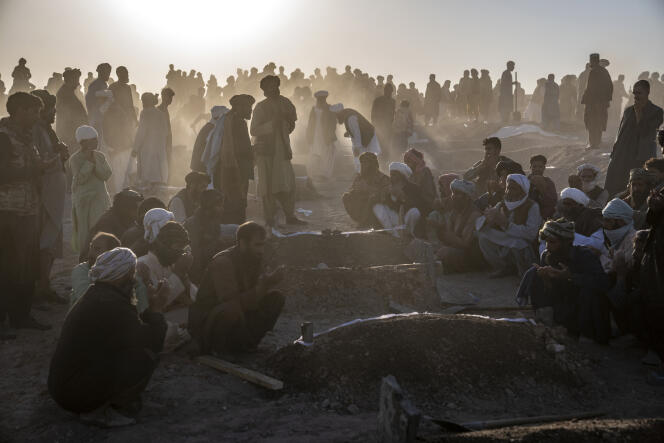Rescuers are still working hard on Tuesday October 10 to search the rubble of houses devastated by the powerful earthquake which killed more than 2,000 people in western Afghanistan, but the hope of finding survivors is dwindling. hour by hour.
Equipped with shovels and picks, volunteers have been working tirelessly since the magnitude 6.3 earthquake struck on Saturday, followed by eight aftershocks, in the province of Herat. Earthquakes are common in Afghanistan, but this is the deadliest to hit this poor country in more than twenty-five years. New aftershocks were felt Monday in the same area.
“There are families who no longer have anyone alive”sighs Ali Mohammad, 50, about the village of Nayeb Rafi, where 2,000 families previously lived. “There is no one left, not a woman, not a child, no one. » In the neighboring village of Siah Ab, mass funerals were held on Monday for around 300 victims from surrounding communities. Hundreds of bodies, wrapped in a white sheet, were placed on the ground, while villagers who had come to pay their respects crossed their arms in prayer. “I thought I was dreaming, everything was razed”relates Ismaïl, 30 years old, who, like many Afghans, only has one name. ” There is not anybody. »
According to the UN, “100%” houses were destroyed in eleven villages in the rural district of Zendeh Jan, located some 30 kilometers northwest of the city of Herat, capital of the province of the same name. “People are trying to search and pull their families out of the debris”Disaster Management Ministry spokesperson Mullah Janan Sayeq told reporters on Monday, describing a “very bad situation”.
Local and national authorities have given sometimes conflicting figures on the number of people killed and injured. But the disaster management ministry on Sunday put the death toll at 2,053. “We cannot give exact figures for the dead and injured because they fluctuate”however, Mullah Sayeq explained on Monday.
“A crisis on top of another crisis”
The World Health Organization (WHO) estimates that 11,000 people from 1,655 families were affected by the earthquake and its aftershocks. Trucks full of food, water and blankets reached isolated villages, where blue tents were pitched amid the ruins.
The Taliban, who regained power in August 2021, will face a major logistical challenge: rehousing residents as winter approaches. The authorities have complicated relations with international humanitarian organizations. They banned women from working for the United Nations (UN) and non-governmental organizations (NGOs), making it difficult to assess the needs of families in the most conservative parts of the country.
Amnesty International has called on the Taliban government to ensure that rescue and humanitarian assistance efforts are carried out “without discrimination” and guarantee NGOs a “secure and unrestricted access” to the affected regions. “It is crucial that all aid meets the needs of the most at-risk groups, who often face multiple challenges in crisis situations, including women”said Zaman Sultani, South Asia researcher at Amnesty.
Most rural houses in the country are made of sun-dried mud bricks and wooden support posts. Several generations generally live under the same roof. Save the Children mentioned “a crisis on top of another crisis”. According to its country director, Arshad Malik, “The extent of the damage is terrifying. The number of people affected by this tragedy is truly overwhelming”.
This new tragedy comes at a time when Afghanistan is already suffering from a serious humanitarian crisis, with the widespread withdrawal of foreign aid since the Taliban’s return to power. The province of Herat, which has 1.9 million inhabitants according to World Bank data, has also been hit for years by a drought which has paralyzed many agricultural communities already plagued by countless difficulties.
The World Application
The Morning of the World
Every morning, find our selection of 20 articles not to be missed
Download the app
Afghanistan frequently experiences earthquakes, particularly in the Hindu Kush mountain range, near the junction between the Eurasian and Indian tectonic plates. In June 2022, a 5.9 magnitude earthquake left more than a thousand dead and tens of thousands homeless in the poor province of Paktika (South-East).
